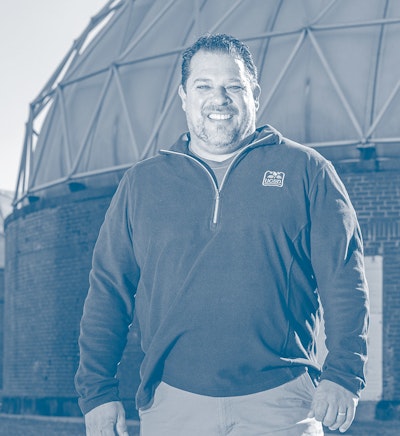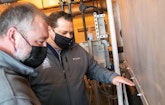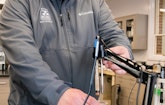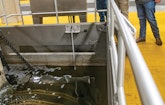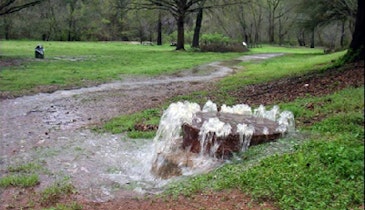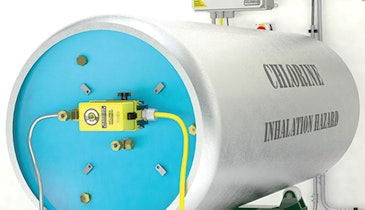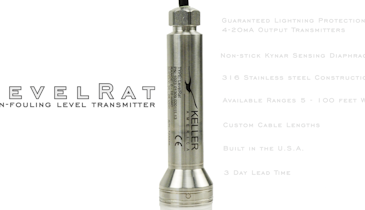
The team at the Urbana and Champaign Sanitary District includes, from left, Layne DelValley, lead operator; Bruce Rabe, laboratory supervisor; Justin Profancik, operations supervisor; and Wade Lagle, director of operations.
Many high school students find their first jobs at McDonald’s or Burger King. Not Wade Lagle.
“I didn’t really want to work at a fast food restaurant, even though there’s not a lot of options for kids when they turn 16,” says Lagle. “So when my city had a summer job opening at their wastewater plant in 1984, I decided to go down there to see what it entailed and if I liked it.”
He did like it, and so he spent his summer working at the Flora (Illinois) wastewater treatment plant. “I started out doing all the summer help, things like painting and cleaning buildings,” he says. “But then it transitioned into training at the wastewater plant.
“I actually helped the guys operate and do maintenance, collect samples and run process control testing. I learned these things and then worked at the plant two hours a week, Monday through Friday, through my high school job co-op program.”
The next summer, Lagle was back at the Flora plant: “One of the operators had back surgery and was off work for the entire summer. So I was able to work as essentially a full-time operator. That was when I actually decided that this could be a career path for me.” In June 1986 he became a full-time operator.
Today Lagle is director of operations at the Urbana and Champaign (Illinois) Sanitary District. In 2020 he received the Operator of the Year award from the Illinois Association of Water Pollution Control Operators. His many recognitions include 33 consecutive years as a Safe Worker award recipient at the district. For the last 35 years, wastewater treatment has been his life’s focus and his professional passion.
“Wastewater treatment is never boring,” says Lagle. “It’s a new challenge every day.”
Lifelong love of water
Lagle was born and raised in Flora. His dad was a maintenance foreman, and his mother did various jobs as she took care of Wade, his two brothers and one sister.
From the earliest age, Lagle was entranced by water. Even today, “I love to go swimming and fishing. Working in the water industry was just kind of a natural thing for me to do.”
After finishing high school in Flora and his second summer at the treatment plant, Lagle enrolled at Southern Illinois University at Edwardsville’s Environmental Resources Training Center: “It was a one-year program that taught how to basically operate and maintain water and wastewater treatment plants. I then did my internship at the Urbana & Champaign Sanitary District, and they offered me a position. So that’s how I got started.”
Starting as an operator in August 1987, Lagle became a laboratory analyst in January 1989. “I worked in the lab until August 2012, when I became operations supervisor,” he says. “I was then promoted to director of operations in May 2021, when the former director, Jackie Christiansen, retired.”
A fruitful career
As director of operations, Lagle oversees two wastewater treatment facilities. The larger Northeast Wastewater Treatment Plant in Urbana, with near-perfect effluent compliance for the last five years, has a five-year average daily flow of 13.8 mgd. The smaller Southwest Wastewater Treatment Plant in Champaign, with perfect effluent compliance for the last five years, has a five-year average daily flow of 7.0 mgd.
“As director of operations, you have to basically oversee everything,” says Lagle. “I’m responsible for the operations department, the laboratory department, our pretreatment program and hauled waste that’s brought to our facility by our industrial clients.” He also handles project management, budget planning and a long list of other duties.
In executing his responsibilities, Lagle is backed by two supervisors, 12 full-time operators (all Illinois EPA certified), two full-time lab analysts and the district’s mechanical/electrical staff. “Justin Profancik is my operations supervisor,” says Lagle. “He went to the same technical program as I did and is very passionate about wastewater.”
Bruce Rabe, laboratory supervisor, has been with the district for 10 years and has 32 years’ experience in the industry. Layne DelValley has been lead operator for 15 years. He holds a Class 1 license. UCSD’s other operators are Mark Muller, Tom Vlahovich, Jim Langheim, Mary DeRuntz, Tyler Huson, Trent Lyons, Matt Fraley, Charly Ilunga, Brad Izatt, Doug Bushue and Jason McDaniel.
In concert with his team, Lagle has a number of key accomplishments. They include reducing energy usage at the Northeast plant by 1,500 MWh (20%) in 2014 and implementing a modified bio-P process at that location — cutting effluent nutrient loading to the Saline Branch Drainage Ditch, which ultimately feeds the Ohio River, by nearly half over the past six years.
This last point is of particular importance to Lagle, since it is related reducing hypoxia (low oxygen) in the Gulf of Mexico, to which the district’s effluent eventually flows. “We’ve done our part,” says Lagle. “We’ve removed an additional 60,000 pounds a year of phosphorus in our receiving stream at our Urbana facility alone.”
Lagle has also helped the district generate nearly 3,000 MWh per year with a combined Caterpillar heat and power system at the Northeast plant. In addition, he and his team have reduced that plant’s chemical usage (including a 35% reduction in polymers). And they have maintained a biosolids land application program since 2013, saving more than $100,000 annually.
Continuous improvements
The district has a long and storied history, but had humble beginnings. “The first wastewater treatment process constructed in the city of Urbana was a septic tank,” Lagle says. “The process was constructed in 1897 at the site of the present Northeast plant.”
In 1922, the Urbana and Champaign Sanitary District was organized. “The first wastewater treatment plant was dedicated in 1924 and is presently known as the Northeast Wastewater Treatment Plant,” he says. “The original facility consisted of coarse screening, Imhoff tanks, fixed nozzle trickling filters and sludge drying beds.”
The Northeast WWTP has undergone several major plant expansions since 1924. “Today’s plant consists of fine screens, grit removal, primary clarification, secondary treatment consisting of activated sludge and the same fixed nozzle trickling filter from 1924,” says Lagle. The process also includes secondary clarification, tertiary ammonia nitrification towers and cloth disk filtration (Aqua-Aerobic Systems), disinfection and dechlorination.
Excess flows receive primary clarification with coagulation, chlorination and dechlorination with a separate discharge to the Saline Branch Drainage Ditch.
The biosolids process consists of anaerobic digestion, dewatering with centrifuges (Alfa Laval), and methane gas utilization from combined heat and power generation (Caterpillar engines). The biosolids are land-applied.
In 1968, due to increasing population, the Southeast plant was constructed. Its original plant design used coarse screening, grit removal, activated sludge treatment, clarifiers, aerobic digesters and biosolids lagoons.
Since then, the Southwest plant has also seen several expansion projects. “Today’s plant consists of fine screens, grit removal, secondary treatment with anaerobic/oxic activated sludge biological nutrient removal, clarifiers, tertiary ammonia nitrification towers and cloth disk filtration (Aqua Aerobics Systems), and UV disinfection (TrojanUV),” Lagle says.
All waste activated sludge is thickened and trucked to the Northeast plant for further treatment. Excess flows receive primary clarification with chlorination and dichlorination and are then blending with the main plant discharge to the Copper Slough, part of the Mississippi River watershed.
Noteworthy challenges
During his many years with the district, Lagle has faced some noteworthy challenges.
For instance, “We did have a five-inch rainfall that took place over three or four hours,” he says. “Even though we don’t have a combined collection system, we still saw water flows go five times higher than what we usually see. Fortunately, we had done our best to be ready for such peak events beforehand.”
In another situation, a tornado hit the area and caused a power outage. Normally that would not have been a problem because both treatment plants are fed by two separate power grids. However, it so happened that one of the grids was already offline for servicing, leaving the Southwest plant on the remaining grid when the tornado knocked it out.
“We ended up experiencing a complete power failure for six hours,” Lagle says. “Getting everything up and running once the electricity came on was a real challenge.”
In a similar power-related circumstance, a blown transformer forced the district to shut down the Northeast plant for eight hours. At least that event was planned, enabling Lagle and his team to plan for the downtime.
Before it occurred, they freed up storage space by pumping out the largest primary clarifier tank and using both excess-flow clarifiers, while shutting off half of the lift stations feeding the plants. “That allowed us to reduce the flow into the plant and store up to eight hours of flow without having to discharge anything,” Lagle notes.
Beyond those events, Lagle loves to take challenges of his own making. Being a seriously competitive person, he takes part in events such as the Water Environment Federation’s Operations Challenge (with the Central States Water Environment Association), and wins industry awards based on his dedication, high standards and unrelenting hard work.
“In 2017, our team won the Process Control and Laboratory events at WEFTEC, so that was pretty exciting,” says Lagle. “That was the first year I had participated in the Operations Challenge, so it was a very cool experience. Given that our team members only get to meet a couple of times a year, it was awesome that we could be that successful.
“Then in 2018, I was fortunate to be selected as Operator of the Year by the Illinois Water Environment Association. Our Northeast plant was nominated for the 2021 Illinois Association of Water Pollution Control Operators Group 1 Plant of the Year.”
No plans to retire
With almost 40 years in the wastewater industry, Lagle has dedicated his life to this profession. So is he ready to retire? Hardly. “I never dreamed I would have the opportunity to be in the position that I’m in now,” he says. “And I look forward to working in this position for another five to 10 years.
“After all, we’re doing long range planning at both of our facilities right now. I don’t know that I’ll see that planning all the way through, but I would like to get it in motion and prepare for the next 20 to 25 years for our sanitary district. So no, I won’t be quitting any time soon.”
